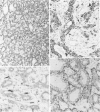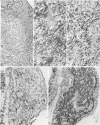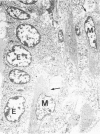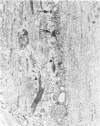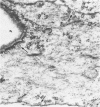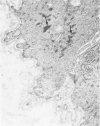Abstract
Myoepithelial cell tumors of the mammary gland have been observed in several mammalian species and are composed of a single cell type (myoepithelium) or, more often, present as a biphasic process including neoplastic ductal epithelial cells. In dogs, these are common tumors, but in humans they are rare neoplasms of the breast, and little is yet known of their pathogenesis, particularly with respect to myoepithelial origin. The present report describes bicellular mammary gland tumors arising from the duct epithelium that were induced in (C57BL/6NCr X DBA/2NCr)F1 (B6D2F1) mice by four weekly oral applications of 1 mg 7,12-dimethylbenz[a]anthracene (DMBA) starting at 8 weeks of age. Mammary tumors developed 7 to 8 months later in 14 of 57 mice, and most showed great morphologic resemblance to human adenomyoepitheliomas and myoepithelial carcinomas. Ultrastructurally, the induced tumors were composed of cuboidal epithelium with a microvillous border originating from the lining duct epithelium and plump oval or highly elongated cells that were identified as myoepithelial in origin. These spindle cells contained abundant microfilaments in parallel orientation, some with focal densities and intermediate filaments that frequently formed loose bundles or compact tonofibrils. The myoepithelial cells possessed well-developed desmosomes and plasma membrane caveolae and were regularly bordered by single or reduplicated basement membranes. By immunohistochemistry, strong immunoreactivity was observed for actin in the myoepithelial tumor component only, whereas cytokeratin was variably present in both duct epithelium and myoepithelium. Neoplastic myoepithelial cells stained purple with phosphotungstic acid hematoxylin (PTAH) and brilliant red with Masson's trichrome. It is suggested that DMBA-induced mouse mammary gland adenomyoepitheliomas and myoepithelial carcinomas may serve as very useful animal models to study myoepithelial tumorigenesis.
Full text
PDF








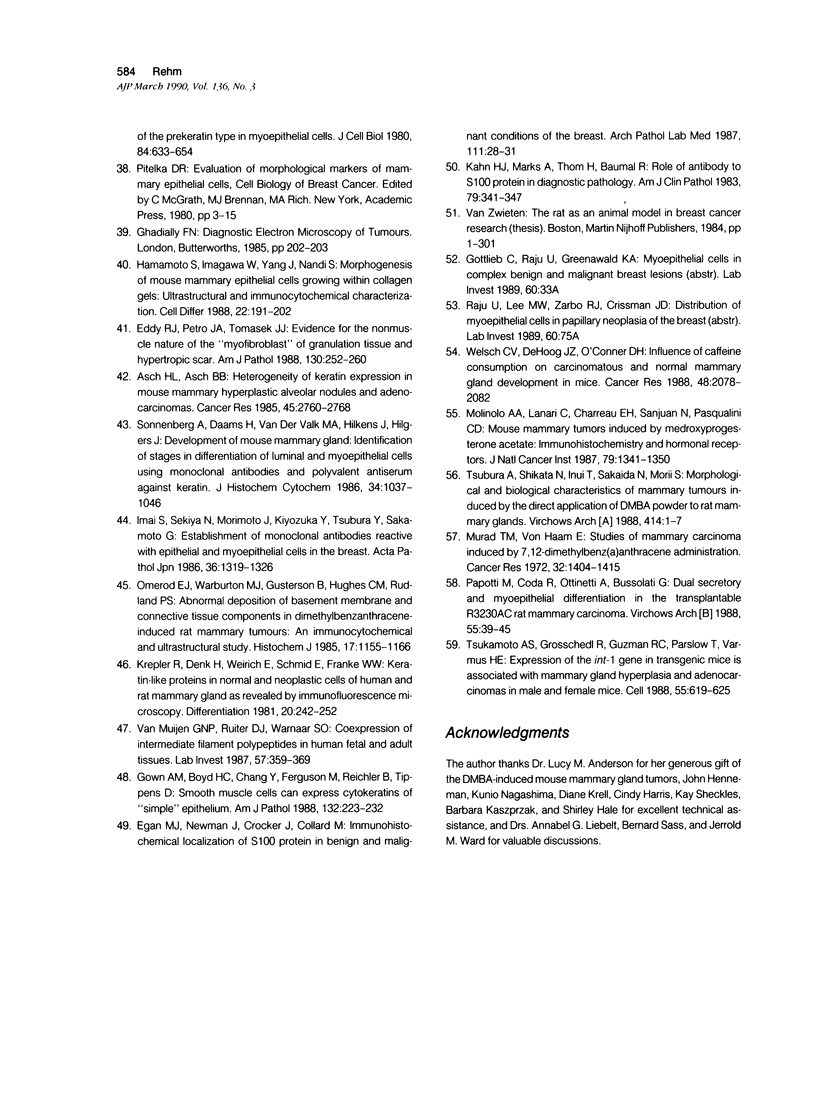
Images in this article
Selected References
These references are in PubMed. This may not be the complete list of references from this article.
- Anderson L. M., Hagiwara A., Giner-Sorolla A., Kovatch R. M., Rehm S., Riggs C. W., Rice J. M. N-nitrosocimetidine as a modifier of chemically-initiated tumors in mice. Cancer Lett. 1988 Nov;42(3):159–167. doi: 10.1016/0304-3835(88)90300-x. [DOI] [PubMed] [Google Scholar]
- Asch H. L., Asch B. B. Heterogeneity of keratin expression in mouse mammary hyperplastic alveolar nodules and adenocarcinomas. Cancer Res. 1985 Jun;45(6):2760–2768. [PubMed] [Google Scholar]
- Bigotti G., Di Giorgio C. G. Myoepithelioma of the breast: histologic, immunologic, and electromicroscopic appearance. J Surg Oncol. 1986 May;32(1):58–64. doi: 10.1002/jso.2930320116. [DOI] [PubMed] [Google Scholar]
- Cartagena N., Jr, Cabello-Inchausti B., Willis I., Poppiti R., Jr Clear cell myoepithelial neoplasm of the breast. Hum Pathol. 1988 Oct;19(10):1239–1243. doi: 10.1016/s0046-8177(88)80159-x. [DOI] [PubMed] [Google Scholar]
- Decorsière J. B., Thibaut I., Bouissou H. Les proliférations adéno-myoépithéliales du sein. Ann Pathol. 1988;8(4-5):311–316. [PubMed] [Google Scholar]
- Ebbenhorst Tengbergen W. J. Morphological classification of mammary tumours in the mouse. Pathol Eur. 1970;5(3):260–272. [PubMed] [Google Scholar]
- Eddy R. J., Petro J. A., Tomasek J. J. Evidence for the nonmuscle nature of the "myofibroblast" of granulation tissue and hypertropic scar. An immunofluorescence study. Am J Pathol. 1988 Feb;130(2):252–260. [PMC free article] [PubMed] [Google Scholar]
- Egan M. J., Newman J., Crocker J., Collard M. Immunohistochemical localization of S100 protein in benign and malignant conditions of the breast. Arch Pathol Lab Med. 1987 Jan;111(1):28–31. [PubMed] [Google Scholar]
- Frei R., Sulser H., Egloff B., Spycher M., Heitz P. U. Das Myoepitheliom der Mamma. Pathologe. 1989 Jan;10(1):48–52. [PubMed] [Google Scholar]
- Gown A. M., Boyd H. C., Chang Y., Ferguson M., Reichler B., Tippens D. Smooth muscle cells can express cytokeratins of "simple" epithelium. Immunocytochemical and biochemical studies in vitro and in vivo. Am J Pathol. 1988 Aug;132(2):223–232. [PMC free article] [PubMed] [Google Scholar]
- Hamamoto S., Imagawa W., Yang J., Nandi S. Morphogenesis of mouse mammary epithelial cells growing within collagen gels: ultrastructural and immunocytochemical characterization. Cell Differ. 1988 Feb;22(3):191–201. doi: 10.1016/0045-6039(88)90011-5. [DOI] [PubMed] [Google Scholar]
- Hamperl H. The myothelia (myoepithelial cells). Normal state; regressive changes; hyperplasia; tumors. Curr Top Pathol. 1970;53:161–220. [PubMed] [Google Scholar]
- Imai S., Sekiya N., Morimoto J., Kiyozuka Y., Tsubura Y., Sakamoto G. Establishment of monoclonal antibodies reactive with epithelial and myoepithelial cells in the breast. Acta Pathol Jpn. 1986 Sep;36(9):1319–1326. doi: 10.1111/j.1440-1827.1986.tb02852.x. [DOI] [PubMed] [Google Scholar]
- Jabi M., Dardick I., Cardigos N. Adenomyoepithelioma of the breast. Arch Pathol Lab Med. 1988 Jan;112(1):73–76. [PubMed] [Google Scholar]
- Kahn H. J., Marks A., Thom H., Baumal R. Role of antibody to S100 protein in diagnostic pathology. Am J Clin Pathol. 1983 Mar;79(3):341–347. doi: 10.1093/ajcp/79.3.341. [DOI] [PubMed] [Google Scholar]
- Krepler R., Denk H., Weirich E., Schmid E., Franke W. W. Keratin-like proteins in normal and neoplastic cells of human and rat mammary gland as revealed by immunofluorescence microscopy. Differentiation. 1981;20(3):242–252. doi: 10.1111/j.1432-0436.1981.tb01179.x. [DOI] [PubMed] [Google Scholar]
- Medina D. Serial transplantation of chemical carcinogen-induced mouse mammary ductal dysplasias. J Natl Cancer Inst. 1979 Feb;62(2):397–405. [PubMed] [Google Scholar]
- Molinolo A. A., Lanari C., Charreau E. H., Sanjuan N., Pasqualini C. D. Mouse mammary tumors induced by medroxyprogesterone acetate: immunohistochemistry and hormonal receptors. J Natl Cancer Inst. 1987 Dec;79(6):1341–1350. [PubMed] [Google Scholar]
- Mori M., Ninomiya T., Okada Y., Tsukitani K. Myoepitheliomas and myoepithelial adenomas of salivary gland origin. Immunohistochemical evaluation of filament proteins, S-100 alpha and beta, glial fibrillary acidic proteins, neuron-specific enolase, and lactoferrin. Pathol Res Pract. 1989 Feb;184(2):168–178. [PubMed] [Google Scholar]
- Morinaga S., Nakajima T., Shimosato Y. Normal and neoplastic myoepithelial cells in salivary glands: an immunohistochemical study. Hum Pathol. 1987 Dec;18(12):1218–1226. doi: 10.1016/s0046-8177(87)80404-5. [DOI] [PubMed] [Google Scholar]
- Murad T. M., Von Haam E. Studies of mammary carcinoma induced by 7,12-dimethylbenz(a)anthracene administration. Cancer Res. 1972 Jul;32(7):1404–1415. [PubMed] [Google Scholar]
- Nathrath W. B., Wilson P. D., Trejdosiewicz L. K. Immunohistochemical localisation of keratin and luminal epithelial antigen in myoepithelial and luminal epithelial cells of human mammary and salivary gland tumours. Pathol Res Pract. 1982;175(2-3):279–288. doi: 10.1016/S0344-0338(82)80114-3. [DOI] [PubMed] [Google Scholar]
- Ormerod E. J., Warburton M. J., Gusterson B., Hughes C. M., Rudland P. S. Abnormal deposition of basement membrane and connective tissue components in dimethylbenzanthracene-induced rat mammary tumours: an immunocytochemical and ultrastructural study. Histochem J. 1985 Oct;17(10):1155–1166. doi: 10.1007/BF01002540. [DOI] [PubMed] [Google Scholar]
- Palmer T. E., Monlux A. W. Acid mucopolysaccharides in mammary tumors of dogs. Vet Pathol. 1979 Sep;16(5):493–509. doi: 10.1177/030098587901600501. [DOI] [PubMed] [Google Scholar]
- Papotti M., Coda R., Ottinetti A., Bussolati G. Dual secretory and myoepithelial differentiation in the transplantable R3230AC rat mammary carcinoma. Virchows Arch B Cell Pathol Incl Mol Pathol. 1988;55(1):39–45. doi: 10.1007/BF02896558. [DOI] [PubMed] [Google Scholar]
- Pulley L. T. Ultrastructural and histochemical demonstration of myoepithelium in mixed tumors of the canine mammary gland. Am J Vet Res. 1973 Dec;34(12):1513–1522. [PubMed] [Google Scholar]
- Rosen P. P. Adenomyoepithelioma of the breast. Hum Pathol. 1987 Dec;18(12):1232–1237. doi: 10.1016/s0046-8177(87)80406-9. [DOI] [PubMed] [Google Scholar]
- Sass B., Dunn T. B. Classification of mouse mammary tumors in Dunn's miscellaneous group including recently reported types. J Natl Cancer Inst. 1979 May;62(5):1287–1293. [PubMed] [Google Scholar]
- Schürch W., Potvin C., Seemayer T. A. Malignant myoepithelioma (myoepithelial carcinoma) of the breast: an ultrastructural and immunocytochemical study. Ultrastruct Pathol. 1985;8(1):1–11. doi: 10.3109/01913128509141504. [DOI] [PubMed] [Google Scholar]
- Sonnenberg A., Daams H., Van der Valk M. A., Hilkens J., Hilgers J. Development of mouse mammary gland: identification of stages in differentiation of luminal and myoepithelial cells using monoclonal antibodies and polyvalent antiserum against keratin. J Histochem Cytochem. 1986 Aug;34(8):1037–1046. doi: 10.1177/34.8.2426332. [DOI] [PubMed] [Google Scholar]
- Strickler J. G., Hegstrom J., Thomas M. J., Yousem S. A. Myoepithelioma of the lung. Arch Pathol Lab Med. 1987 Nov;111(11):1082–1085. [PubMed] [Google Scholar]
- Tamura S., Enjoji M., Toyoshima S., Terasaka R. Adenomyoepithelioma of the breast. A case report with an immunohistochemical study. Acta Pathol Jpn. 1988 May;38(5):659–665. [PubMed] [Google Scholar]
- Tarin D. Fine structure of murine mammary tumours: the relationship between epithelium and connective tissue in neoplasms induced by various agents. Br J Cancer. 1969 Jun;23(2):417–425. doi: 10.1038/bjc.1969.54. [DOI] [PMC free article] [PubMed] [Google Scholar]
- Thorner P. S., Kahn H. J., Baumal R., Lee K., Moffatt W. Malignant myoepithelioma of the breast. An immunohistochemical study by light and electron microscopy. Cancer. 1986 Feb 15;57(4):745–750. doi: 10.1002/1097-0142(19860215)57:4<745::aid-cncr2820570411>3.0.co;2-8. [DOI] [PubMed] [Google Scholar]
- Toto P. D., Hsu D. J. Product definition in a case of myoepithelioma. Oral Surg Oral Med Oral Pathol. 1986 Aug;62(2):169–174. doi: 10.1016/0030-4220(86)90040-x. [DOI] [PubMed] [Google Scholar]
- Tsukamoto A. S., Grosschedl R., Guzman R. C., Parslow T., Varmus H. E. Expression of the int-1 gene in transgenic mice is associated with mammary gland hyperplasia and adenocarcinomas in male and female mice. Cell. 1988 Nov 18;55(4):619–625. doi: 10.1016/0092-8674(88)90220-6. [DOI] [PubMed] [Google Scholar]
- Van Muijen G. N., Ruiter D. J., Warnaar S. O. Coexpression of intermediate filament polypeptides in human fetal and adult tissues. Lab Invest. 1987 Oct;57(4):359–369. [PubMed] [Google Scholar]
- Weidner N., Levine J. D. Spindle-cell adenomyoepithelioma of the breast. A microscopic, ultrastructural, and immunocytochemical study. Cancer. 1988 Oct 15;62(8):1561–1567. doi: 10.1002/1097-0142(19881015)62:8<1561::aid-cncr2820620817>3.0.co;2-z. [DOI] [PubMed] [Google Scholar]
- Welsch C. W., DeHoog J. V., O'Connor D. H. Influence of caffeine consumption on carcinomatous and normal mammary gland development in mice. Cancer Res. 1988 Apr 15;48(8):2078–2082. [PubMed] [Google Scholar]
- Young R. H., Clement P. B. Adenomyoepithelioma of the breast. A report of three cases and review of the literature. Am J Clin Pathol. 1988 Mar;89(3):308–314. doi: 10.1093/ajcp/89.3.308. [DOI] [PubMed] [Google Scholar]
- Zarbo R. J., Oberman H. A. Cellular adenomyoepithelioma of the breast. Am J Surg Pathol. 1983 Dec;7(8):863–870. [PubMed] [Google Scholar]



